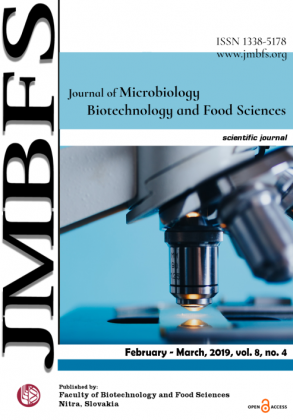EFFECT OF ESSENTIAL OILS OF LAMIACEAE PLANTS ON THE PENICILLIUM COMMUNE
DOI:
https://doi.org/10.15414/jmbfs.2019.8.4.1111-1117Keywords:
P. commune, essential oils, antifungal activity, vapor phaseAbstract
The aim of this research was to determine the inhibitory effect of vapor phase of eight essential oils (EOs) on the growth of seven strains of Penicillium commune isolated from moldy milk products. Another objective was to determine the minimum inhibitory doses (in vitro and probit analyses) of EOs, which at concentration 625 μL.L-1 of air completely inhibited the growth of all strains. The antifungal activity was evaluated by the micro-atmosphere method. Thyme, red thyme, peppermint, mint, and savory completely inhibited the growth of strains during cultivation at 25 °C and 5 °C. Basil, rosemary, and sage EOs have different effects on the growth of P. commune strains. EOs that completely inhibit the growth of all strains were used to determine their minimum inhibitory doses (MIDs). The best results 62.5 μL.L-1 of air and 125 μL.L-1 of air 7th day at 25 °C of incubation showed red thyme EO. Similar results were also found in thyme EO, but the MID inhibiting the growth of the one strain was 250 μL.L-1 of air. MIDs of savory and peppermint were from 125 to 500 μL.L-1 of air. Mint EO had the highest MID (from 250 to 625 μL.L-1 of air). On the 14th day of incubation we found the same MIDs, respectively higher. It was found that EOs have different effects on individual strains of P. commune. According to probit analyses, the most effective tested EOs were red thyme and thyme, less effective peppermint and savory, and the least effective was mint EO.Downloads
Download data is not yet available.
Downloads
Published
2019-02-01
How to Cite
TanÄinová, D., Medo, J., MaÅ¡ková, Z., Foltinová, D., & Ãrvay, J. (2019). EFFECT OF ESSENTIAL OILS OF LAMIACEAE PLANTS ON THE PENICILLIUM COMMUNE . Journal of Microbiology, Biotechnology and Food Sciences, 8(4), 1111–1117. https://doi.org/10.15414/jmbfs.2019.8.4.1111-1117
Issue
Section
Microbiology
License
Copyright (c) 2019 Dana TanÄinová, Juraj Medo, Zuzana MaÅ¡ková, Denisa Foltinová, Július Ãrvay

This work is licensed under a Creative Commons Attribution 4.0 International License.
All papers published in the Journal of Microbiology, Biotechnology and Food Sciences are published under a CC-BY licence (CC-BY 4.0). Published materials can be shared (copy and redistribute the material in any medium or format) and adapted (remix, transform, and build upon the material for any purpose, even commercially) with specifying the author(s).





